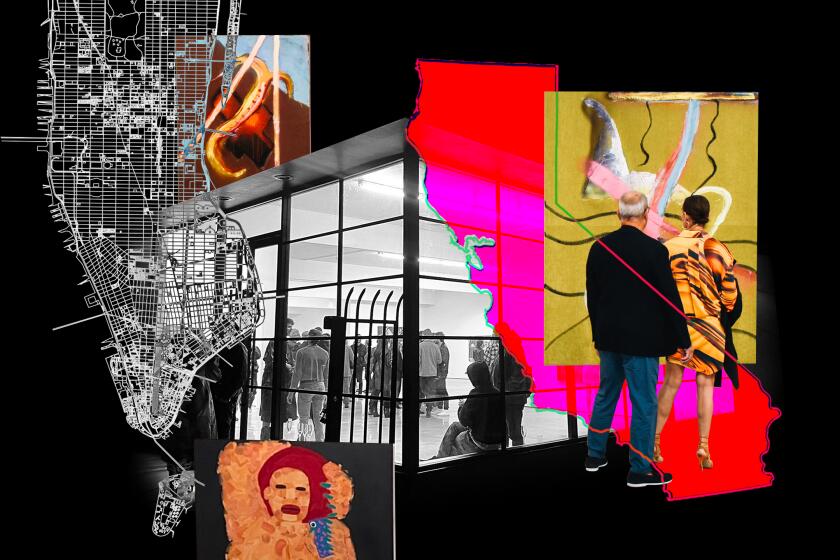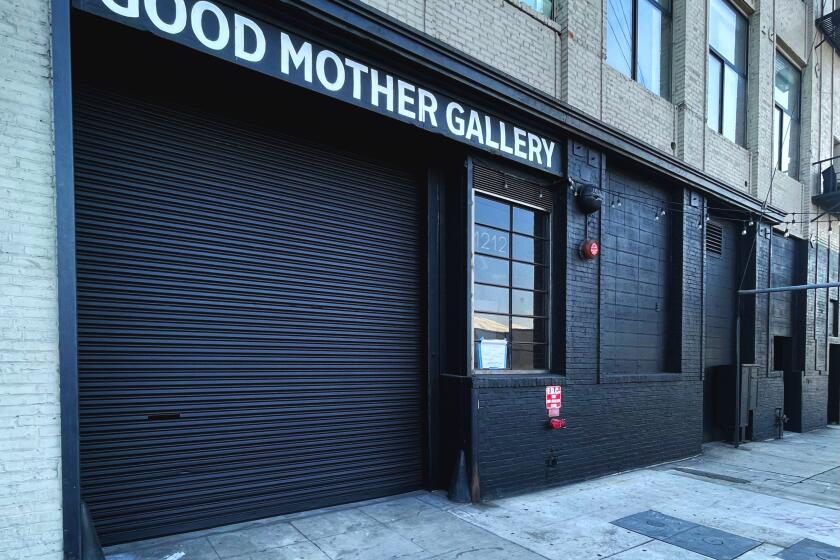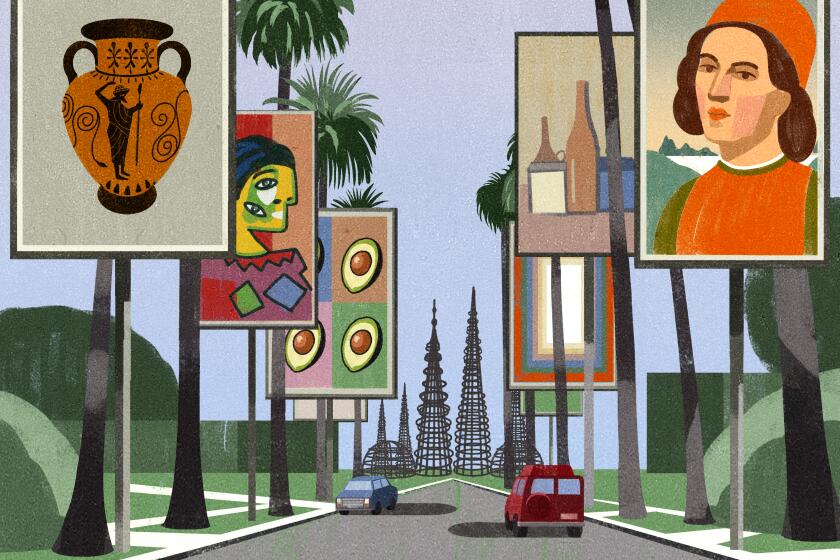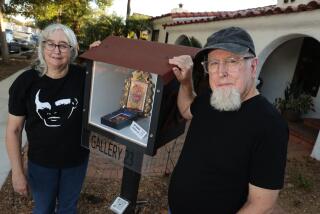Crates and all: Kathy Grayson’s Hole gallery unearths rarely seen art from around L.A.
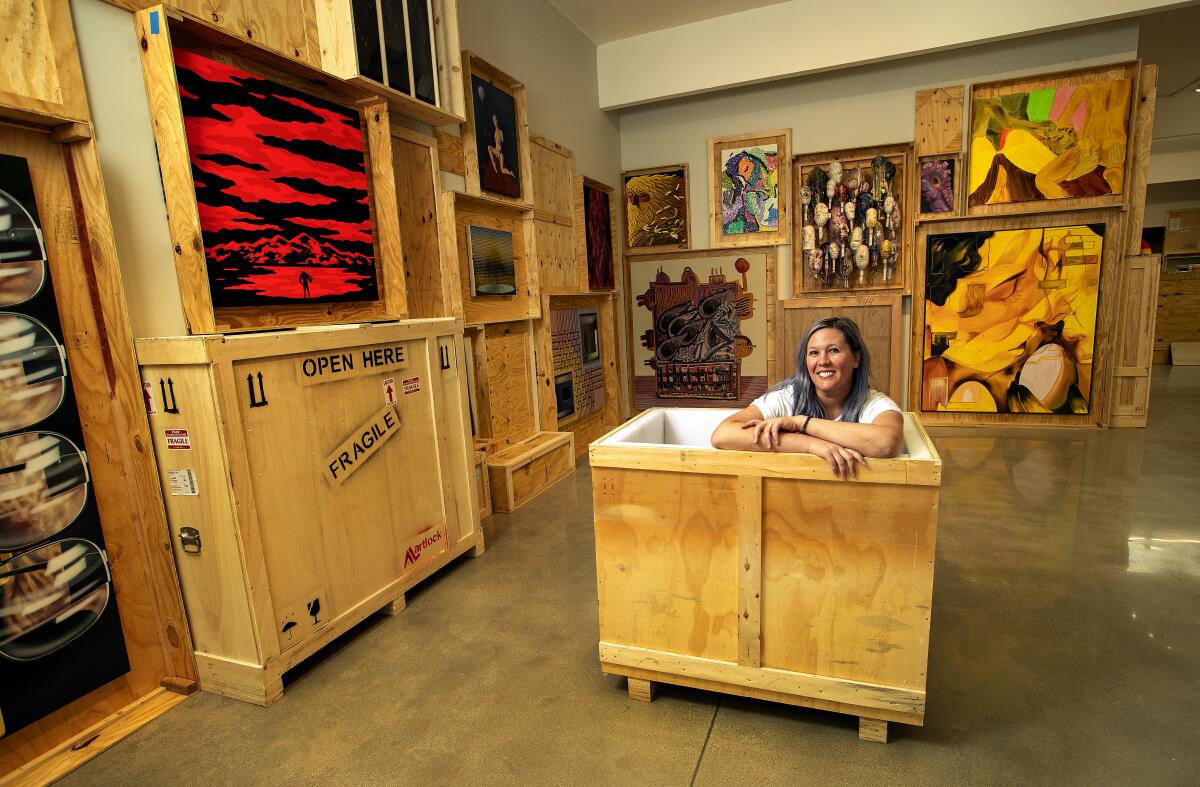
- Share via
Kathy Grayson stares intently at several large paintings, trying to decide whether they complement one another on a vast wall in front of her. She absent-mindedly twists her light purple hair on either side of her face and ties it in a knot under her chin like a bonnet. It stays there for a moment before falling into place again on her shoulders.
“I don’t know if this works,” she says of an abstract work imbued with deep gray hues. “It might be too dark.”
Grayson stands on the polished concrete floor in the middle of her contemporary art gallery, the Hole, which opened an outpost on La Brea Avenue in Los Angeles a little over a year ago. This is Grayson’s third location. She opened her first in the Bowery in New York City in 2010 and another in TriBeCa in 2021.
‘The question is: Are they moving to L.A. to contribute to the cultural landscape here or to take from it?’ one artist asks.
On this temperate Friday afternoon, Grayson is overseeing the installation of a group show called “Storage Wars” — a nod to the A&E auction-battle TV competition series — which is set to open the following night. A crew of about six workers bustles around the space, and the sound of screws being drilled into plaster shreds the air. The 9,000-square-foot gallery is filled with plywood shipping crates designed to hold, protect and transport fine art.
These crates, however, are not meant to be carted out. Instead, they provide the literal frames for the work in the show, which Grayson organized to highlight art that has long been boxed up and tucked away from admiring eyes.
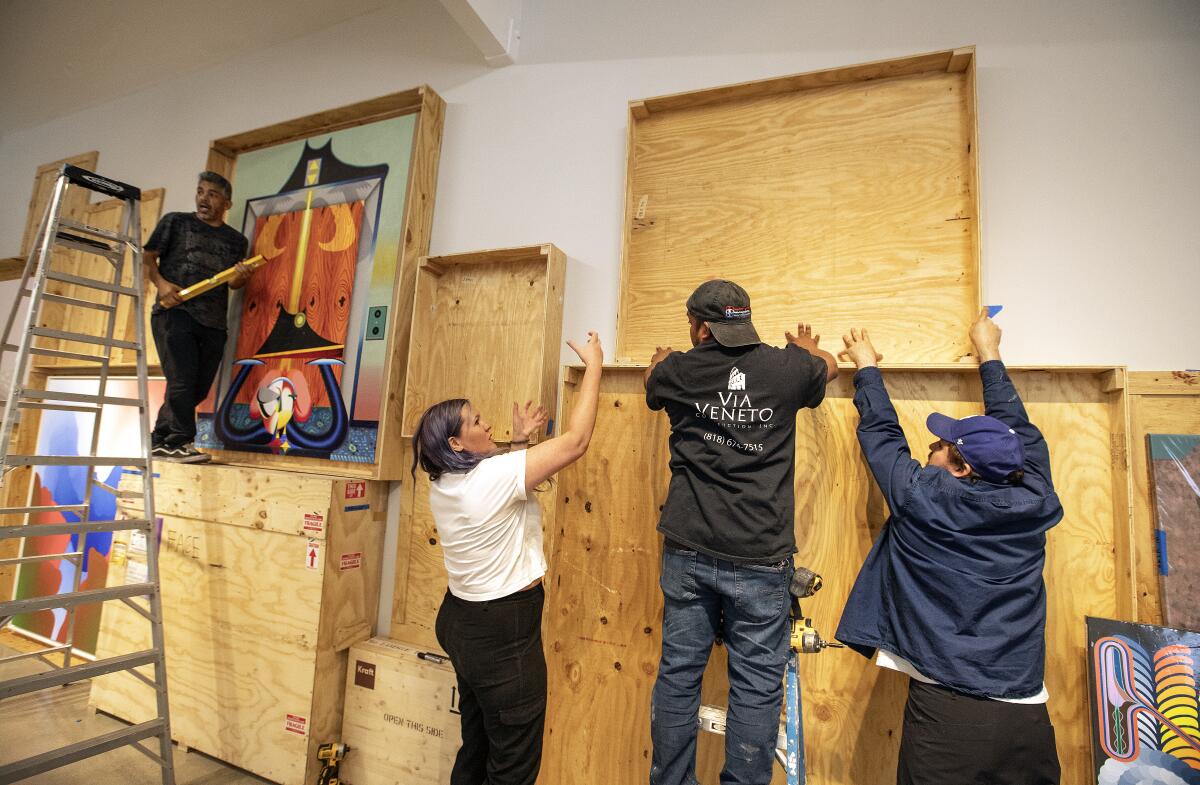
Individual artworks can spend an inordinate amount of time in crates — it’s the art world’s dirty little not-so-secret secret, says Grayson. It happens when pieces are out of rotation at museums and galleries; after a collector purchases a work and doesn’t have wall space for it; or while pieces are traveling between art fairs, where they are on view for only a few days before being crated up again and shipped off elsewhere.
For “Storage Wars,” Grayson embarked on a community-building project with gallery owners, collectors and artists across the city, asking them to unbox and share one of their favorite pieces of art that has been in hiding for too long. She wasn’t sure what kind of a response she’d get but was thrilled to discover that it was generous and enthusiastic, with more than 80 participants sharing work that has rarely, if ever, been seen publicly.
Collectors including Sue Hancock, Jason Swartz and Hooman Dayani pitched in, as did galleries Nino Mier, Nicodim and Gavlak, along with artists Pedro Pedro, KAWS and Lisa Anne Auerbach, who each offered a personal favorite from their own stash.
By the time the show launches early Saturday evening, the gallery walls are decorated with a hodgepodge of eclectic artworks — each peeking out of the parameters of its former plywood prison. Sculptures are simply stacked on top of the crates they came in. The crowd of art lovers sips sake out of square wood boxes in keeping with the night’s theme.
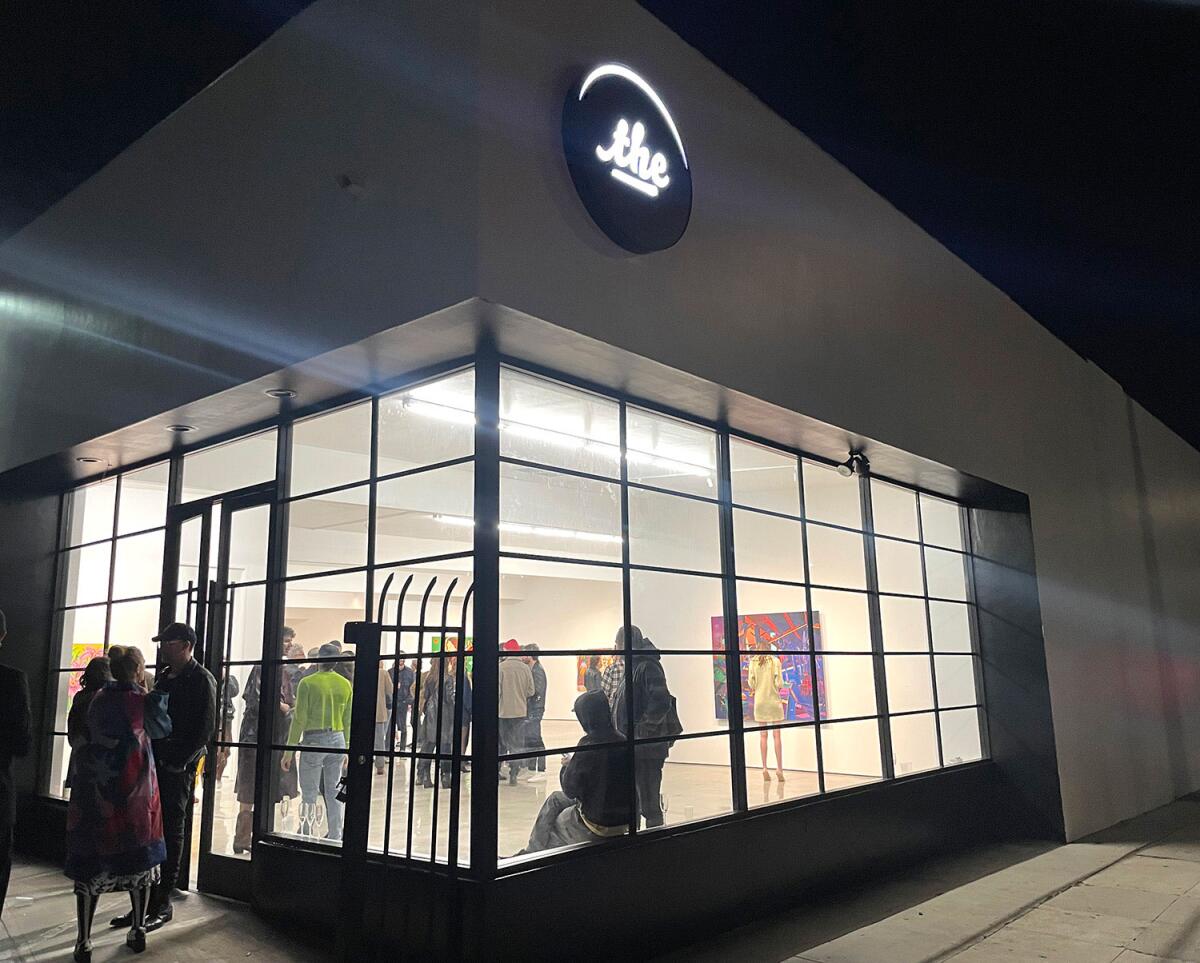
At a little after 8 p.m., a select group of guests wanders into the 2,500-square-foot kitchen just off the main gallery for a celebratory family-style dinner made by Grayson’s partner in the gallery, Raymond Bulman. Bulman is debonair — a deeply personable art enthusiast who went to business school in Rome and has long made it a habit to feed artists and their friends after shows in New York.
With the Hole in L.A., he now has an in-house kitchen, enabling him to take his love of hosting and his considerable culinary skills to the next level. Saturday’s menu includes focaccia with whipped ricotta, mortadella with shaved parmigiana, fregola sarda alle vongole, rigatoni amatriciana, and boneless chicken with caper, anchovy and parsley sauce.
“Everyone has to be excited for these things to have energy,” Bulman says of gallery openings. “And so serving dinner is a big part of that. For me, it’s enjoyable. I get to host people and hang out with my artists after a show.”
Good Mother Gallery recently opened its Los Angeles arm near the 6th Street Viaduct after starting in Oakland in 2014 with a community-centric ethos.
Bulman and Grayson believe in cultivating an artistic community that is contagious in its creativity. During dinner, guests chat about their current projects over negronis (stunning!) as plate after plate of food is passed.
Michele Lorusso, a young artist from Mexico City, talks about an art and poetry project he is working on in conjunction with activists on Skid Row; a gallery owner confers with a collector; and painter Vanessa Prager flags down a friend she hasn’t seen in ages.
“Kathy has an artist’s mindset in her curation,” Prager says. “She will make a show a work of art, and this is such a good example of that. It’s fun and it has such a good spirit to it.”
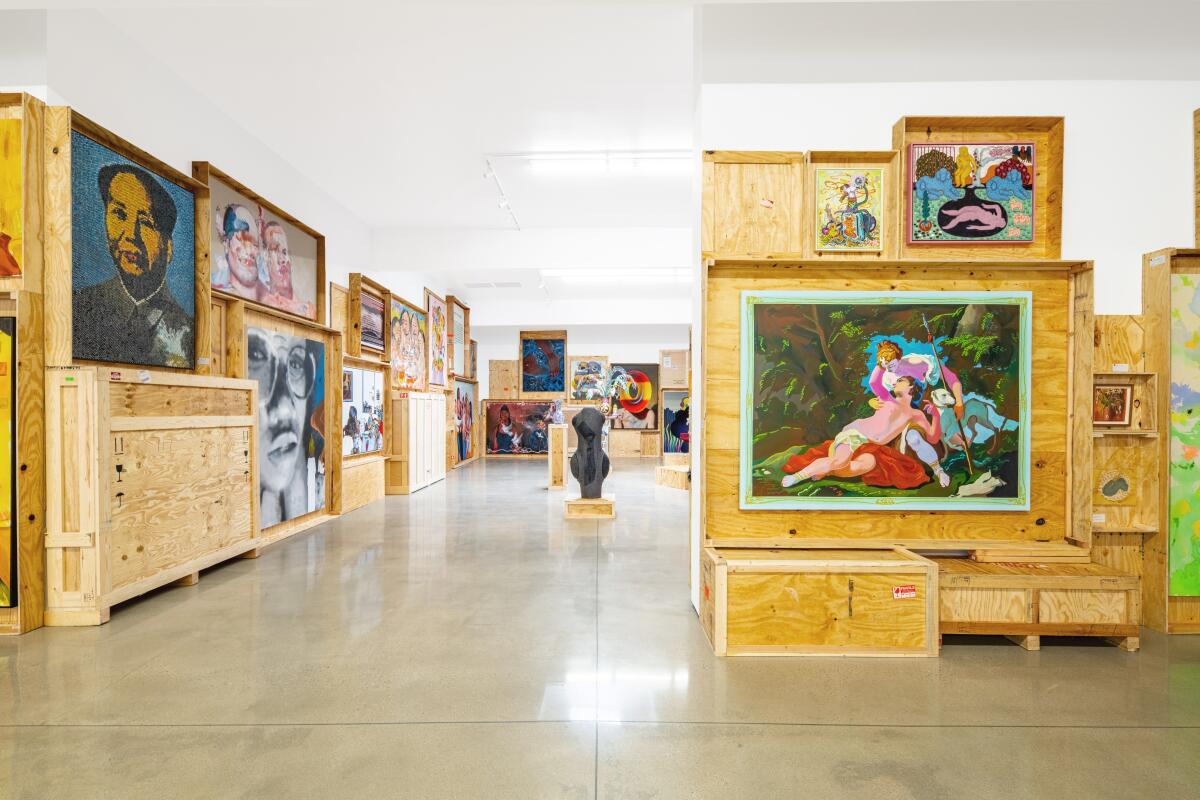
By turning the Hole into a bicoastal operation, Grayson wants her gallery to match the ambitions of her artists — giving them fresh and inspiring places to show their work. Pedro says when he first showed at her L.A. gallery, he was “terrified because it was so massive.” But it presents an exciting opportunity, he says.
Grayson was raised in Washington, D.C. Her parents were scientists and she attended the Sidwell Friends School, where Chelsea Clinton was her lab partner. She later enrolled at Dartmouth, starting off in pre-med and playing tennis. By her sophomore year, she switched majors and sports, studying art history and becoming captain of the rugby team.
While at Dartmouth, she founded the first student art gallery. She named it “Area” because she says she had to fight with the administration for space, and it ended up giving her only a single wall. She launched a fundraising campaign to pay for a second wall. For her first show, she printed out all the emails it took to get the wall built, titling the project, “Wall With the E-trail of Its Own Making,” in homage to a 1961 work by Robert Morris called “Box With the Sound of Its Own Making.” The administration was not impressed, and Grayson says she was called in front of the disciplinary committee for publishing confidential information.
These are the 16 must-see works of art from permanent collections at the Huntington, LACMA, the Getty, MOCA, the Norton Simon, UCLA’s Hammer Museum and more.
The experience burnished the blossoming iconoclast inside of her, and by the time she worked as an intern for the 2002 Whitney Biennial curated by Lawrence Rinder, she had become fascinated by collectives of interdisciplinary artists who came from outside established art school settings. Groups like Forcefield, composed of artists who dropped out of Rhode Island School of Design who worked and lived at Fort Thunder, an abandoned warehouse-turned-underground-venue featuring a refrigerator door that opened to another room. They created knitwear costumes, 3-D video art, paintings, installations and sculptures. They also played in a noise band.
“That vibe became what I brought to Deitch Projects,” says Grayson of the New York gallery owned by art dealer and curator Jeffrey Deitch, which hired her first as a receptionist and quickly promoted her to curator and director when it became clear that she had a knack for selling art.
Grayson stayed with Deitch until it closed in 2010 when its namesake was appointed director of the Museum of Contemporary Art, Los Angeles. Supported by friends and fans, including photographer and WireImage co-founder Jeff Vespa, who became an early investor, Grayson launched the Hole, naming it after a club and lesbian bar that she describes as “truly lawless.” It closed in 2004, as all truly lawless spaces eventually do.

“Everybody should be able to walk into a contemporary art gallery and have a meaningful experience with art,” Kathy Grayson says. “It should be as popular as music or literature.”
Thirteen years later, the Hole represents 25 artists, including Pedro, Alex Gardner, Matt Hansel, Caitlin Cherry and Vickie Vainionpaa.
Even with its expanded footprint, Grayson says the Hole intends to stay true to its original mission: meeting artists where they work and live in order to continue building the community aspect of art-making.
“Artists self-organize into interesting groups, which become movements, and the best thing as a curator is not to pick from all over the place, but to support what the artists are already doing,” she says.
Grayson pauses when asked what she’s learned over the years, including from her formative years with Deitch.
“Art should be for everybody,” she says, adding that she hopes to continue stripping away the aspects of the contemporary art culture that cause people to feel intimidated and unwelcome. “You should use your art gallery to broaden the audience of art. Everybody should be able to walk into a contemporary art gallery and have a meaningful experience with art. It should be as popular as music or literature.”
‘Storage Wars’
Where: The Hole, 844 N. La Brea Ave., L.A.
When: 11 a.m. to 6 p.m. Tuesdays through Saturdays. Closed Sundays and Mondays. Through Aug. 19.
Cost: Free
Info: (323) 297-3288, thehole.com
More to Read
The biggest entertainment stories
Get our big stories about Hollywood, film, television, music, arts, culture and more right in your inbox as soon as they publish.
You may occasionally receive promotional content from the Los Angeles Times.
